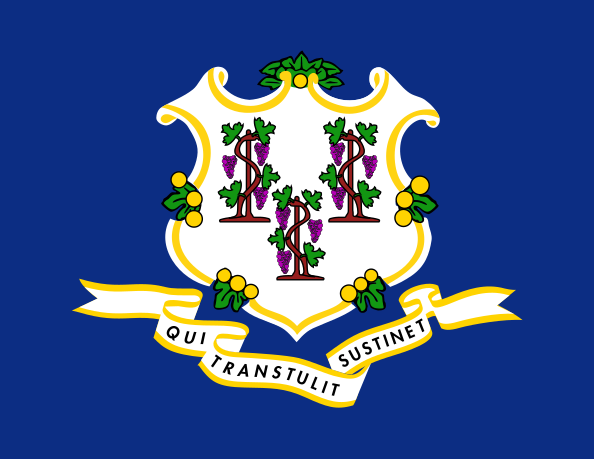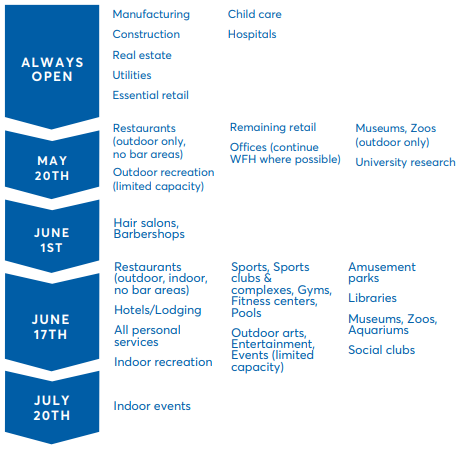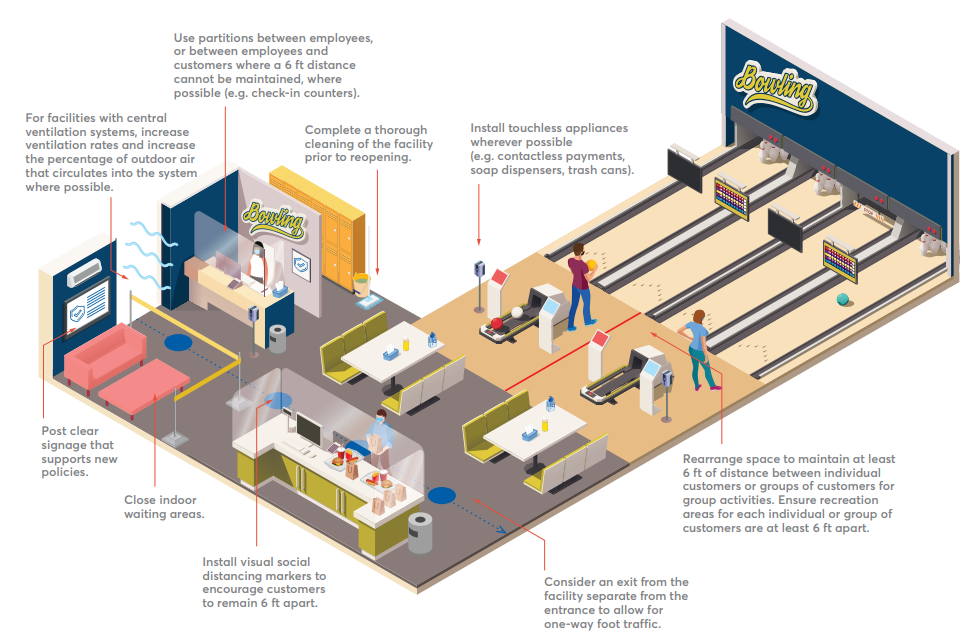Title Page
-
Site
-
Conducted on
-
Prepared by
-
Location
SECTOR RULES FOR JUNE 17TH REOPEN
-
GOAL
Proactively protect public health and speed up the pace of economic, educational, and community recovery while restoring Connecticut’s quality of life. -
1 - SAFETY FIRST<br>We will reopen society safely and securely with a proactive program that safeguards the health of our vulnerable residents, continues physical distancing, and provides clear safeguard rules for businesses and 1 institutions deemed safe to reopen.
-
2 - SCIENCE-DRIVEN<br>Our strategy will rely on a scientifically validated set of public health interventions. Patient assessment, testing, proactive tracing, field studies, and public health guidance will be deployed simultaneously to contain infection.
-
3 - PREPARED<br>We will work closely with hospitals and health systems to procure and distribute critical personal protective equipment, and assess capacity of beds and ventilators to ensure optimal standard of care
-
4 - CHOICE<br>Individual businesses within sectors allowed to open are empowered to make their own choice on when they reopen. When they open, they must comply with rules we lay out to safeguard their employees and customers
-
5 - DYNAMIC<br>We include a suite of tools to inform an adaptive plan that can be nimbly scaled or rolled back rapidly based on real-time critical health metrics.
HOW WE WILL OPEN OUR ECONOMY SAFELY
-
Our plan to open the economy will address two factors:
WHAT businesses can open and when.
HOW businesses must operate if they choose to open.
WHAT
-
• We know that some businesses put employees and customers at greater risk of transmission.
-
• We will prioritize opening businesses that pose a lower transmission risk and drive outsized impact on the economy.
-
• Transmission risk is defined as contact intensity and modification potential of businesses.
-
- Contact intensity considers contact proximity, contact length, and number of contacts.
-
- Modification potential considers the businesses’ ability to socially distance and sanitize in accordance with regulations.
-
• We will assess the impact on state economic health with a focus on number of employed individuals, total GDP impacted, and impact on small businesses that<br> make up the backbone of our economy.
HOW
-
• We will provide clear operational guidance to businesses on how to reopen while ensuring the safety of both employees and customers.
-
• Guidance will include social distancing and hygiene, as well as the use of personal protection – for business operators, workers, and customers.
-
• The goal is to not only open safely, but create confidence in our society across employers, employees, and customers.
-
• The level of guidance will gradually become less restrictive over time, as our confidence in the ability to monitor and contain the disease increases.
WHAT: SECTOR REOPENING OVER TIME
-
-
The state will open its economy with a gradual approach.<br>The first set of businesses started reopening when we saw a sustained 14-day decline in hospitalizations, had adequate testing capacity, had a contact tracing system in place, and had procured sufficient PPE. The timing for that reopen was May 20th.
HOW: SAFEGUARDS
-
As we continue to reopen select businesses on June 17th, we will open at our strictest controls onbusiness operations and societal interaction. This will include, among other measures:
-
• Capacity limit of 50% for most businesses that reopen.
-
• Strict cleaning and disinfection protocols in all settings.
-
• Those who can work from home should continue to do so.
-
• Those in high-risk groups (comorbidities) and over the age of 65 should continue to stay safe and stay home.
-
• Facemasks should continue to be worn in public at all times.
-
• Social gatherings will be restricted in accordance to the Governor's executive order.
-
As we see progress on a defined set of public health metrics (detail to follow), we will gradually
loosen safeguards. This will allow for the next set of businesses to open and potentially for
businesses already open to operate with additional leeway. We expect this will occur over the coming months.
As always, we will make decisions based on data and science. Our plan intentionally allows for
sufficient time for learning, adoption of behaviors, and ultimately the achievement of improved
health metrics that create the necessary environment for new business operations. If public health metrics deteriorate, the State may choose to revert back to stricter safeguards.
INDOOR RECREATION
-
OVERVIEW
As Connecticut's indoor recreation venues reopen, the most important consideration will be the health and safety of employees and customers. Businesses must exercise caution throughout reopening, ensuring strict adherence to the protocols listed here. Those businesses that are not able to meet the rules listed here shall delay opening until they are able.
While these rules provide a way for indoor recreation venues to reopen in as safe a manner as possible, risks to customers and employees cannot be fully mitigated. Customers who choose to visit indoor recreation venues during this time should be fully aware of potential risks. Individuals over the age of 65 or with other health conditions should not visit indoor recreation venues, but
instead continue to stay home and stay safe.
Businesses should take these rules as the minimum baseline of precautions needed to protect public health in Connecticut. Individual businesses should take additional measures as recommended by industry guidelines or by common sense applied to their particular situation.
We urge customers to stay vigilant and pay attention as to whether indoor recreation venues they frequent are faithfully implementing these rules
These rules are not intended to govern sports-related businesses. Those businesses should refer to the appropriate sector rules published by DECD. -
REOPEN RULES FOR INDOOR RECREATION VENUES
Indoor recreation businesses may open at up to 50% capacity; however, businesses should limit customers to the number of customers that can be appropriately supervised by staff to ensure continuous compliance with rules for mask wearing, social distancing, and cleaning/disinfecting of equipment and common areas. Businesses for which no maximum capacity is on record may determine maximum Phase II capacity as 1 person (including employees) per 150 square feet.
Any food service taking place at indoor recreation venues will adhere to the Sector Rules for Restaurants. The information here can be supplemented with guidance from other industry groups, some of which are listed below. These rules may be updated as conditions evolve.
FURTHER RESOURCES
FDA
https://www.fda.gov/food/food-safety-during-emergenci
es/best-practices-retail-food-stores-restaurants-and-food
-pick-updelivery-services-during-covid-19
OSHA
https://www.osha.gov/Publications/OSHA3990.pdf -
PLAN FOR REOPENING<br>Share these rules with your employees and inform them of any additional specific measures being taken in response to COVID-19.
-
PROGRAM ADMINISTRATOR<br>Appoint a program administrator who is accountable for implementing these rules.
-
CLEANING PLAN<br>Develop cleaning checklists that incorporate these rules. Ensure it is clear which employees are responsible for<br>implementing the plans.
-
TRAINING<br>The employer shall institute a training program and ensure employee participation in the program. Training shall be provided at no cost to the employee and during working hours. The training materials shall be presented in the language and at the literacy level of the employees. Employers shall continuously update staff on changes to these Sector Rules. The training shall include:<br>• Guidelines outlined in this document<br> • Protocols on how to clean and use cleaning products (incl. disinfectants) safely<br> • Additional guidance can be found here: https://osha.washington.edu/sites/default/files/documents/FactSheet_Cleaning_Final_UWDEOHS_0.pdf<br><br>NOTE: If any on-site duties are subcontracted, it is the employer’s responsibility to ensure subcontractors are also appropriately trained.
-
PERSONAL PROTECTION<br>Estimate required personal protection for employees and begin procuring.
-
THOROUGH CLEANING<br>Complete a thorough cleaning of facility prior to reopening, including but not limited to:<br> • Bathrooms<br> • Kitchens<br> • Seating area<br> • All equipment
-
LOG EMPLOYEES<br>Maintain a log of employees on-premise over time, to support contact tracing.
-
SHIFTS<br>Stagger shift start/stop times, break times,and lunchtimes to minimize contact across employees. <br>• Consider cohorting staff within each shift (e.g. keeping the same shift schedules and avoiding mixing staff<br> across shifts).
-
CAPACITY TRACKING<br>Employers are responsible for enforcing revised capacity limits (50%).
-
CERTIFICATION<br>Complete the self-certification on the DECD website to receive a Reopen CT badge. Once complete, businesses can choose to post the badge on-site and on social media to advertise adherence to CT rules and build customer confidence.
-
-
Use partitions between employees, or between employees and customers where a 6 ft distance cannot be maintained, where possible (e.g. check-in counters)
-
For facilities with central ventilation systems, increase<br>ventilation rates and increase the percentage of outdoor air<br>that circulates into the system where possible.
-
Complete a thorough cleaning of the facility prior to reopening.
-
Install touchless appliances wherever possible (e.g. contactless payments, soap dispensers, trash cans).
-
Post clear signage that supports new policies
-
Close indoor waiting areas.
-
Install visual social distancing markers to encourage customers to remain 6 ft apart.
-
Consider an exit from the facility separate from the entrance to allow for one-way foot traffic.
-
Rearrange space to maintain at least 6 ft of distance between individual customers or groups of customers for<br>group activities. Ensure recreation areas for each individual or group of customers are at least 6 ft apart.
-
ENTRY & EXIT<br>Consider an exit from the facility separate from the entrance to allow for one-way foot traffic.
-
SIGNAGE<br>Post clear signage that supports new policies, e.g.:<br>• Social distancing protocols<br>• Cleaning and disinfection protocols<br>• Personal protection (face masks, gloves)<br>• Employees should stay home if sick/experiencing symptoms<br>• Customers should not enter if they are experiencing symptoms<br>• Additional signage can be found here:<br>https://portal.ct.gov/DECD/Content/Coronavirus-Business-Recovery/COVID-19-Signage-for-Download
-
SOCIAL DISTANCING MARKERS<br>Install visual social distancing markers to encourage customers to remain 6 ft apart (e.g. lines to get movie theater tickets)
-
VENTILATION<br>For facilities with central ventilation systems, increase ventilation rates and increase the percentage of outdoor air that circulates into the system where possible. For facilities where a central ventilation system is not<br>used, window air conditioning units or unit ventilators should be adjusted to maximize fresh air intake into the system; blower fans should be set on low speed and pointed away from room occupants to the extent possible. Ceiling fans should be adjusted so that fans are rotating in a direction that draws air up toward the ceiling rather than down onto occupants. Window fans should be turned to exhaust air out of the window in the direction of the outdoors. Window fans that blow air into a room or free-standing fans that only serve to circulate existing air around a room should not be used.
-
WAITING AREAS<br>Close indoor waiting areas.
-
RECREATION AREAS & SEATING<br>Rearrange space to maintain at least 6 ft of empty space between individual customers or groups of customers for group activities. This may involve moving existing recreation areas or blocking off recreation areas that<br>cannot be moved (e.g. spacing out potter’s wheels to be more than 6 ft apart in a pottery studio or blocking off certain rows in a movie theater). Distance shall be<br>measured from the closest boundary of one customer recreation area to the closest boundary of another customer recreation area.
-
PARTITIONS<br>Use partitions between employees, or between employees and customers where a 6 ft distance cannot be maintained,<br>where possible (e.g. check-in counters).
-
NON-ESSENTIAL AMENITIES<br>• Amenities non-essential to a businesses' main function (e.g. pool table, dart boards, giant Jenga, etc.) are allowed but must be thoroughly cleaned in-between group usage. Markings on the ground shall be used to section off these amenities and ensure they are at least 6 ft away from the closest chair back/person. Only those playing shall be allowed around these areas;others must remain in their seating area. Masks must be worn at all times and no food or drink is allowed in these areas.<br>• Non-essential amenities that cannot be thoroughly cleaned (e.g. cards, board games, etc.) are allowed to be brought to the establishment by customers.
-
TOUCHLESS APPLIANCES<br>Install touchless appliances wherever possible (e.g. contactless payments, paper towel dispensers, soap dispensers, trash cans).
-
HOTLINE FOR VIOLATIONS<br>Post clear signage that includes the state hotline (211) for employees and customers to report potential violations of these rules.
-
FOOD SERVICE<br>All food service shall adhere to the Sector Rules for Restaurants.
-
DISCRETE WORK ZONES FOR EMPLOYEES<br>Employees should operate in specific zones to minimize overlap, where possible.
-
EMPLOYEE EQUIPMENT<br>Ensure employees do not share equipment to the extent possible (e.g. trays). If shared, clean after each use.
-
SELF-SERVICE<br>Self-serve beverage stations are allowed but must adhere to the guidelines below. All other self-serve items (e.g. self-service bowling ball) must remain closed and have staff provide such items regularly.<br>• Hand sanitizer must be made available next to beverage stations and operators must require customers to use before pouring beverages. Only cello or paper wrapped<br>straws and stirrers are allowed. Cups and lids must be from single pull dispenser or other method to minimize contact. Sweeteners, sugars and creamers must be individual packets. Floor markers must be installed to<br>achieve social distancing. Samplings and refills of personal mugs and cups are not allowed. Frequent disinfecting of the beverage station must take place, even during busy times
-
CLEANING TIME<br>Increase time between showings or groups of customers to allow for more thorough cleaning of recreation areas (e.g. movie theater seats, craft studio tables).
-
TICKETING<br>Encourage contactless and/or digital ticketing where possible.
-
GROUPS<br>For group activities, do not combine persons or small groups with other non-related or non-associated persons or small groups.
-
CUSTOMER EQUIPMENT<br>Require customers to use only one piece of equipment during their visit (e.g. one bowling ball). Clean equipment in between customer use (e.g. bounce houses, golf putters). If cleaning or disinfecting equipment is not possible,
-
RESERVATIONS<br>Where possible, reservations should be required
-
PAMPHLETS/PRICING/MENUS<br>Businesses are encouraged to use no-touch or disposable options for pamphlets/pricing/menus (e.g. phone app,<br>whiteboard). If no-touch or disposable options are not commercially possible, businesses must sanitize pamphlets/pricing/menus between uses.
-
PERSONAL PROTECTION FOR EMPLOYEES<br>• All employees are required to wear a facemask or other cloth face covering that completely covers the nose and mouth. Employees that cannot wear a mask due to a medical condition must provide documentation to their employer.<br>• Employees may utilize their own cloth face covering over that provided by their employer if they choose.<br>• Gloves and eye protection are required when using cleaning chemicals.
-
EMPLOYERS ARE RESPONSIBLE FOR PROVIDING PERSONAL PROTECTION TO THEIR EMPLOYEES<br>• If businesses do not have adequate personal protection, they cannot open.
-
PERSONAL PROTECTION FOR CUSTOMERS<br>Customers are required to bring and wear a facemask or other cloth face covering that completely covers the nose and mouth.<br>• Businesses have the right to refuse service to an individual who is not wearing a mask.
-
HAND SANITIZER<br>Hand sanitizer shall be made available at entrance points and common areas, where possible.
-
HANDWASHING<br>Ensure employees wash their hands routinely using soap and water for at least 20 seconds.
Audit Completion
-
Prepared by


















